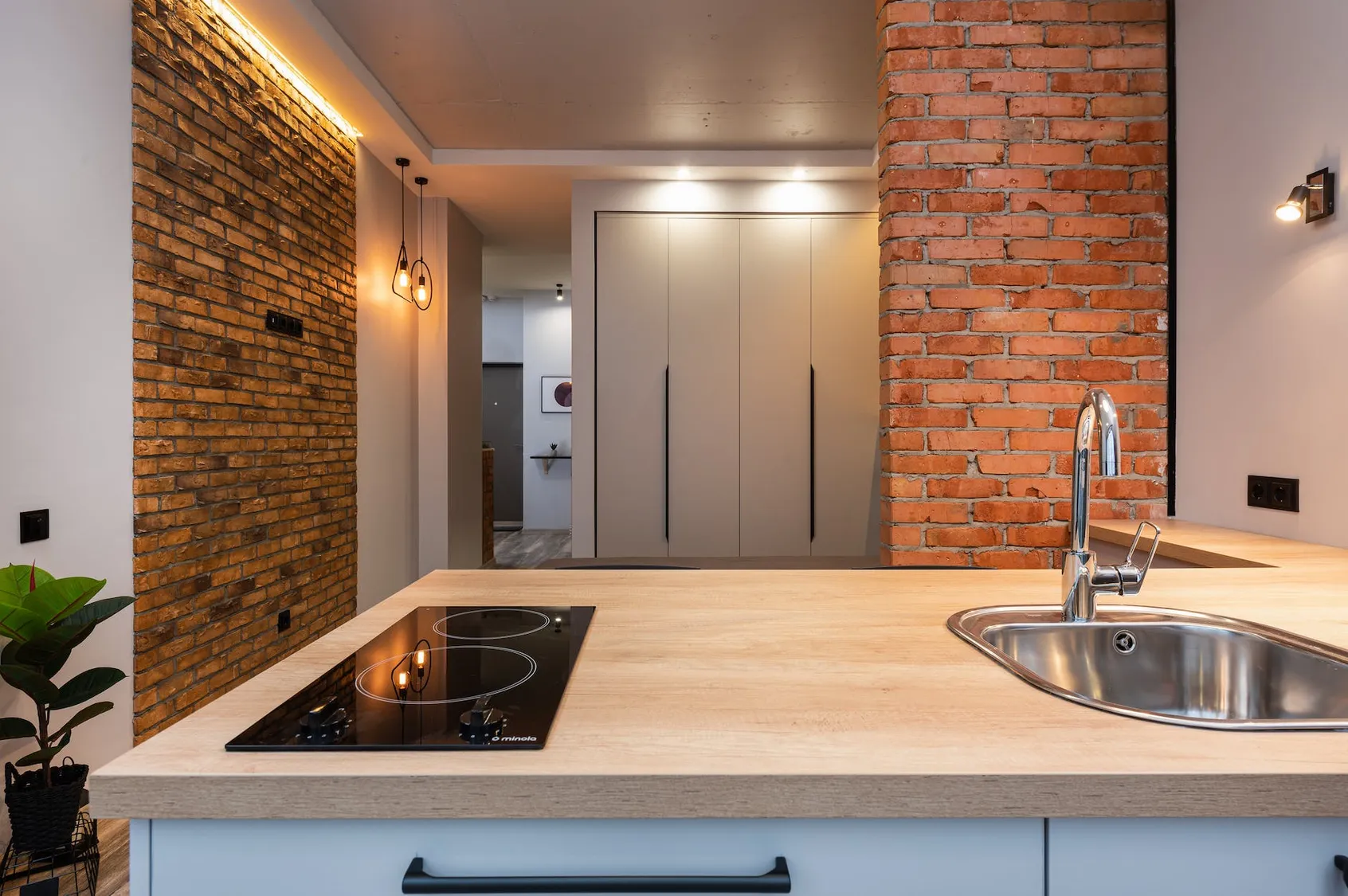Having an outdoor kitchen is a great way to extend your living space and make your outdoor space more functional and enjoyable. However, one of the key questions when designing an outdoor kitchen is, how deep should an outdoor kitchen counter be? This is an important consideration as it will determine the overall height and usability of the counter.
This guide will explore the factors to consider when determining the perfect height for your outdoor kitchen countertop. We’ll look at the various countertop materials, the ideal ergonomic height for comfortable use, and other factors to consider when selecting the perfect height for your outdoor kitchen countertop.
How Deep Should An Outdoor Kitchen Counter Be?
When building an outdoor kitchen, one of the key elements to consider is the depth of the countertop. The depth of the countertop not only affects its aesthetic appeal but also impacts its functionality.
The countertop cannot accommodate larger items like a grill or stovetop if too shallow. Too deep, and you may be wasting space that could be used for storage or additional cooking space. To ensure your outdoor kitchen countertop is the perfect fit for your needs, it’s important to find the right depth.
Typically, outdoor kitchen countertops range from 24 to 36 inches deep, but the ideal depth depends on the size and shape of your outdoor kitchen. If you have a larger area to work with, you may want to opt for a deeper countertop.
The deeper countertops provide more space for larger items like grills and stoves and additional space for food prep and storage. However, a shallower countertop may be better if your outdoor kitchen space is limited.
When selecting the depth of your outdoor kitchen countertop, it’s important to consider its height. The height of the countertop should be comfortable for you to use, regardless of whether you’re standing or sitting.
For example, if you’re of average height, you may want to consider a countertop depth between 30 inches. This depth provides enough space for most items while allowing you to reach items stored on the countertop.
In addition to the depth and height of your outdoor kitchen countertop, you also want to consider the material. Natural stone, granite, and marble are popular for outdoor kitchen countertops. These materials are durable and can withstand the elements. However, they can also be expensive, so you may want to look for more budget-friendly alternatives.
Finally, consider the overall style of your outdoor kitchen. You want to create a space that looks great, functions well, and fits your lifestyle. Look for countertops that complement your outdoor kitchen’s design and the other elements. You can create the perfect outdoor kitchen countertop with the right depth, material, and style.

Features To Consider When Buying An Outdoor Kitchen Countertop
The countertop is one of the most important elements when creating an outdoor kitchen. When selecting a countertop, there are several features to consider.
- Countertop material: Stone, concrete, and stainless steel are popular for outdoor kitchen countertops. Each material has its benefits and drawbacks, so it’s important to consider the pros and cons of each before making a decision.
- Height: Generally speaking, the ideal height for an outdoor kitchen countertop is between 30” and 36”. This height allows for comfortable use while preparing food while also providing enough space to accommodate kitchen appliances. The height should be a few inches higher if the countertop is used for dining.
- Depth: Deeper countertops provide more space for food preparation, while shallower countertops are easier to clean. The optimal depth for an outdoor kitchen countertop is between 25” and 30”. This depth provides a good balance between workable space and ease of cleaning.
- Sealing: The countertop should be properly sealed to protect against the elements. Sealing will help prevent fading, staining, and other damage caused by moisture and sun exposure. Most materials used for outdoor kitchen countertops are already sealed, but ensuring the sealant is in good condition is still important.
Outdoor Kitchen Countertop Materials And Finishes
Outdoor kitchen countertops can be made from various materials, each with advantages and disadvantages.
- Natural stone countertops, such as granite, marble, and soapstone, are incredibly durable and have a timeless look. However, they are expensive and require regular sealing to protect them from staining and wear.
- Concrete countertops are a great option for those looking for a more industrial look. They are extremely durable and can be customized with various colors and textures. However, they require regular sealing and can be difficult to repair if they become damaged.
- Wood countertops like butcher block and bamboo can give an outdoor kitchen a warm, rustic feel. They are less expensive than stone countertops but require regular oiling and maintenance to prevent cracking and warping.
- Laminate countertops are the most affordable option but are not as durable and prone to chipping and wear.
It is also important to consider the overall look of your outdoor kitchen when choosing the countertop height. For a modern look, opt for a lower countertop, while a higher countertop can give a more traditional look. The right countertop height can make all the difference in creating an inviting outdoor kitchen that your family and friends will enjoy for years.
Calculating The Optimal Depth For An Outdoor Kitchen Countertop
The depth of the countertop will determine how comfortable and functional the space is, so it’s important to get it right. The perfect depth for your outdoor kitchen countertop will depend on factors such as the size of your kitchen, the type of countertop material you plan to use, and the activities you’ll be doing in the space. The ideal depth of an outdoor kitchen countertop is usually between 30 and 36 inches.
When calculating the optimal depth for an outdoor kitchen countertop, start with the activities you’ll be doing in the kitchen. If you’ll be using the space for food preparation tasks such as chopping and slicing, a countertop depth of between 30 and 36 inches is recommended. This provides enough space to work comfortably without feeling cramped. If you use the countertop for more casual activities, such as serving food, a shallower depth of about 18 to 24 inches should suffice.
Next, consider the size of your outdoor kitchen. If you have a smaller space, a shallower countertop may be more appropriate as it will help keep the kitchen from feeling cramped. Conversely, if you’re designing a larger outdoor kitchen, you may opt for a deeper countertop to maximize the space.
Finally, consider the material you’ll be using for the countertop. Different materials have different thicknesses and weights, so the depth of the countertop should be adjusted accordingly.
For example, granite and quartz countertops tend to be heavier, so a deeper countertop is recommended to provide adequate support. On the other hand, materials such as laminate and stainless steel are lighter and can be used with shallower countertops.

Width Of Outdoor Kitchen Counter
When it comes to creating the perfect outdoor kitchen counter, the width of the countertop is an important factor to consider. A too-narrow countertop will leave you with limited workspace, while a too-wide countertop can take up too much space in your outdoor kitchen. Generally, the ideal countertop width for an outdoor kitchen is between 24 and 36 inches.
Outdoor Kitchen Countertop Overhang
The countertop overhang is one of the most important considerations when planning an outdoor kitchen. Knowing how deep your outdoor kitchen counter should be is essential for comfort and safety. To ensure the best experience, you’ll want to consider the type of activities you’ll be doing, the size of your outdoor kitchen, and the height of the people using it.
A good rule of thumb regarding countertop overhangs is to select a comfortable depth for everyone. If you plan on using your outdoor kitchen mainly for food preparation, a countertop between 24 and 36 inches deep is ideal. This will give you plenty of space to work and enough room to avoid spills or splatters.
If you plan on using your outdoor kitchen for dining, then you may want to consider a deeper countertop. A countertop between 36 and 48 inches deep is ideal for dining.
Design Ideas For Outdoor Kitchen Countertops
Designing the perfect outdoor kitchen countertop is important in creating a beautiful, functional outdoor living space. It is important to consider the countertop’s size, shape, material, and height when selecting the ideal countertop for your outdoor kitchen.
The ideal countertop height for an outdoor kitchen depends on the size of the space, the intended use of the countertop, and the height of the people who will be using it.
The typical countertop height for an outdoor kitchen is 36 inches, the same height as standard kitchen countertops indoors. If your kitchen is intended for entertaining, it is best to choose a slightly higher than 36 countertop, as this will be more comfortable for guests to use while standing. If the space is small and you plan to use the countertop for food preparation, a lower countertop height of 34/30 inches can be more practical.
The material of the countertop is also important when selecting the perfect outdoor kitchen countertop. Natural stone is durable, easy to clean, and withstand outdoor elements. Granite countertops are often chosen for outdoor kitchen countertops because they are extremely durable and resistant to staining and scratching. You can also choose concrete countertops for an outdoor kitchen, which are great for a modern, industrial look.
Finally, the size and shape of the countertop should be considered when selecting the perfect outdoor kitchen countertop. Countertops that are too large will make the kitchen feel cramped, while countertops that are too small will be impractical for food preparation. A square or rectangular-shaped countertop is usually the best option for an outdoor kitchen, although other shapes, such as L-shaped or U-shaped countertops, can also be chosen.

Tips For Installing An Outdoor Kitchen Countertop
Installing an outdoor kitchen countertop can be a great way to upgrade your outdoor living space and increase the functionality of your backyard. Here are a few tips to keep in mind when installing an outdoor kitchen countertop:
- Choose the right material: When selecting a countertop material for your outdoor kitchen, choosing a material that can withstand the elements is important. Some popular options include granite, concrete, and stainless steel.
- Properly prepare the surface: Before installing your countertop, ensure the surface is clean, dry, and level. This will ensure that the countertop sits evenly and securely.
- Use the right adhesive: When attaching your countertop to the base, use an adhesive specifically designed for outdoor use. This will ensure that your countertop stays in place and remains durable.
- Seal the countertop: To protect your countertop from moisture and stains, it’s important to seal it properly. Use a sealant for outdoor use and follow the manufacturer’s instructions carefully.
- Consider adding a backsplash: A backsplash to your outdoor kitchen countertop can help protect the walls behind it from grease and other stains. Plus, it can add a decorative touch to your outdoor living space.
Maintenance And Cleaning Tips For Outdoor Kitchen Countertops
Maintaining and cleaning outdoor kitchen countertops can be challenging due to exposure to weather elements and outdoor cooking residue. Here are some tips for keeping your outdoor kitchen countertops spotless and well-maintained:
- Clean your countertops daily: Use a soft cloth, soap, and water to wipe your countertops every day. This will help prevent stains from forming and keep them looking clean.
- Avoid using abrasive cleaners: Abrasive cleaners can scratch and damage your outdoor kitchen countertops. Instead, use a gentle cleanser that’s safe for your surface.
- Seal your countertops: Sealing your outdoor kitchen countertops will protect them from stains and damage caused by exposure to the elements. Choose a sealant designed for outdoor use and follow the manufacturer’s instructions.
- Use a cutting board: To avoid scratches and cuts on your outdoor kitchen countertops, use a cutting board when preparing food. This will also help prevent cross-contamination.
- Clean spills immediately: If a spill occurs, clean it up immediately to avoid staining your countertops. Use a soft cloth and a gentle cleanser to remove spills and stains from your outdoor kitchen countertops.
Natural stone countertops may require sealing to protect against staining and damage from water, dirt, and bacteria. Granite and quartz countertops may require regular cleaning and polishing to keep them looking their best.
Safety Considerations For Outdoor Kitchen Countertops
When designing an outdoor kitchen, it’s important to consider safety when selecting materials for your countertops. Here are some considerations to keep in mind:
- Heat resistance: Outdoor kitchen countertops need to be able to withstand high heat and direct sunlight. Granite, concrete, and tile are good outdoor countertops choices because they can handle high temperatures without cracking.
- Non-slip surface: Ensure your countertop material has a non-slip surface to prevent accidents. You don’t want anyone slipping or falling while cooking or chopping food.
- Durability: Outdoor countertops need to be able to withstand weather and temperature changes, so choose a material that is durable and can resist fading, cracking, or chipping over time.
- Easy to clean: Outdoor countertops are exposed to dirt, dust, and debris, so choose a material that is easy to clean and maintain. Stainless steel, for example, is a popular choice because it’s easy to clean and disinfect.
Troubleshooting Common Issues With Outdoor Kitchen Countertops
Regarding outdoor kitchen countertops, a few common issues can arise. Here are some troubleshooting tips to help you address these problems:
- Stains and discoloration – Use a specialized outdoor countertop cleaner to remove stains and discoloration from your countertops. Avoid using abrasive cleaners that can scratch the surface.
- Chipping and cracking – If your countertops are chipping or cracking, it may be due to exposure to extreme temperatures. Consider using a heat-resistant countertop material like granite or stainless steel to avoid these issues.
- Warping and swelling – If your countertops are made of wood, they may warp or swell due to exposure to moisture. To address this issue, ensure that the wood has been properly sealed and use a waterproof cover when not in use.
- Rust – If you are using a metal countertop, it may rust over time. Use a rust remover and reapply a protective coating to prevent further rusting. Consider using a stainless steel countertop to avoid rusting altogether.
Cost Factors For Outdoor Kitchen Countertops
Cost is probably the most important factor in deciding the perfect height for your outdoor kitchen countertop. Depending on your chosen materials, outdoor countertops can range from relatively inexpensive to extremely pricey, from $60-$95 per square foot.
If budget is a major concern, you can look for plastic laminate, concrete, tile, and stainless steel materials. These materials are generally very affordable and can all be used to create a great-looking outdoor kitchen countertop.
In addition to cost, you should also consider the maintenance and durability of the outdoor kitchen countertop. Some materials, such as natural stone, are more expensive but are also much more durable and require less maintenance than other materials. Natural stone is especially great for a busy outdoor kitchen, as it is highly resistant to scratches, chips, and other damage.
Conclusion
In conclusion, the perfect height for your outdoor kitchen countertop depends on your kitchen size and the activities you plan to do there. Consider the typical tasks you will use the counter for and decide on a counter height that works best for you.
Don’t forget to factor in the ergonomics of your space. Designing a well-thought-out outdoor kitchen countertop is the key to having a comfortable and inviting space for cooking and entertaining.
Frequently Asked Questions:
What is the ideal size for an outdoor kitchen?
The ideal size for an outdoor kitchen depends on several factors, including the size of your outdoor space, the type of appliances you plan to install, and the amount of entertaining you plan to do. Generally speaking, a good rule of thumb is to have at least 100 square feet of space for an outdoor kitchen.
How tall should countertops be for an outdoor kitchen?
The standard height for countertops in an outdoor kitchen is 36 inches.
How thick is the outdoor kitchen countertop?
The thickness of an outdoor kitchen countertop will vary depending on the material used. For example, granite countertops are typically 1-1/4″ thick, while concrete countertops range from 1-1/2″ to 2-1/2″ thick.
How much depth do you need for a built-in grill?
The depth required for a built-in grill will depend on the specific model and size of the grill you are installing. Generally, most built-in grills require a depth of at least 24 inches, but some may require up to 30 inches.
What materials are best for an outdoor kitchen countertop?
The best materials for an outdoor kitchen countertop are granite, quartz, concrete, and stainless steel. Granite is the most popular choice due to its durability and resistance to heat and moisture. Quartz is also a great choice because of its low maintenance and non-porous surface. Concrete is a good option for a more natural look and feel. Stainless steel is a good choice for a modern look and easy maintenance.
How much room do I need for an outdoor kitchen countertop?
The size of an outdoor kitchen countertop will depend on the space you have available and the type of countertop you plan to install. Generally, you should plan for at least 24 inches of countertop space per person. If you are planning to install a larger countertop, you may need to allow for more space.
What type of maintenance is required for an outdoor kitchen countertop?
The type of maintenance required for an outdoor kitchen countertop will depend on the material used. Generally, cleaning the countertop regularly with warm water and mild soap is important, and resealing it with a sealant designed for outdoor use every one to two years. Additionally, it is important to immediately wipe up spills and messes and avoid placing hot items directly on the countertop.
Are there any special installation requirements for an outdoor kitchen countertop?
Yes, there are some special installation requirements for an outdoor kitchen countertop. These include using a waterproof sealant to protect the countertop from moisture, using stainless steel screws to secure the countertop to its cabinet, anchoring the countertop to the wall or floor to prevent movement, and making sure to use materials that are suitable for outdoor use and can handle the elements.
